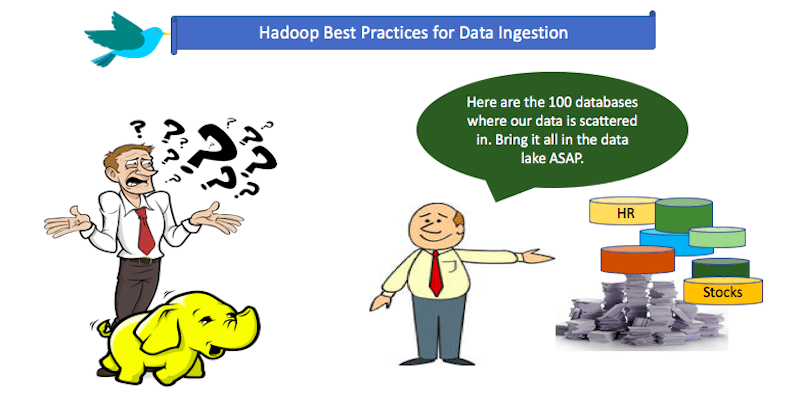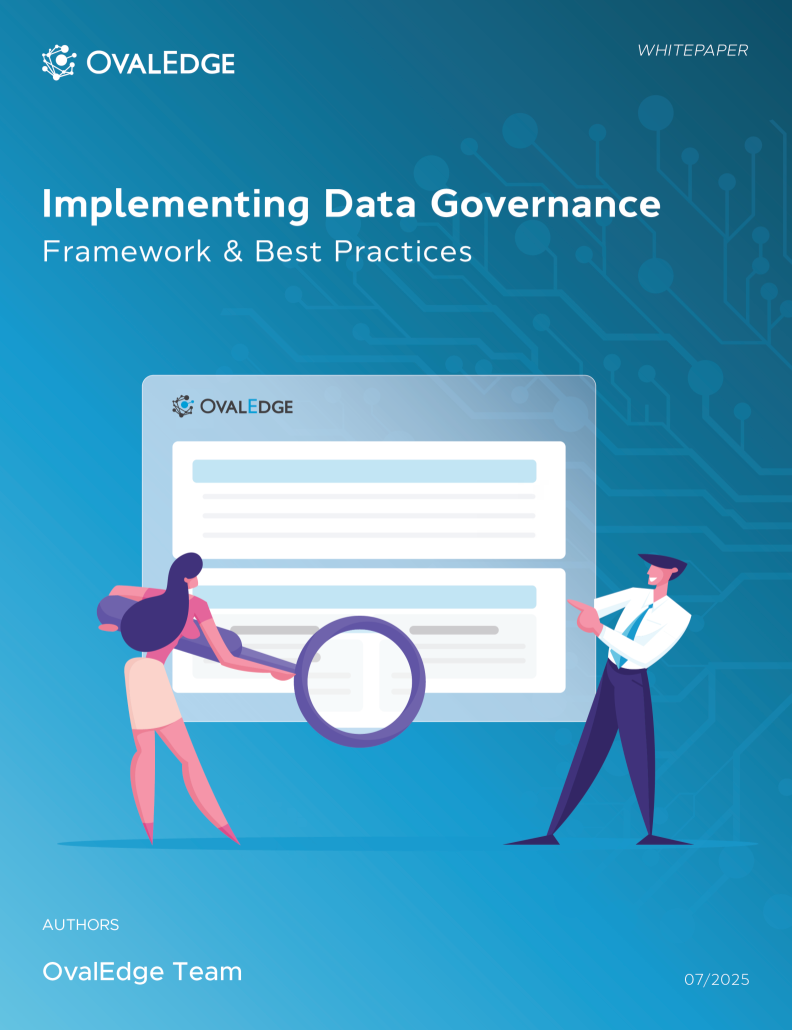Table of Contents
Hadoop Best Practices for Data Ingestion: Optimize Data Loading in 2026
Hadoop Data ingestion is the beginning of your data pipeline in a data lake. It means taking data from various silo databases and files and putting it into Hadoop. Sounds arduous? For many companies, it does turn out to be an intricate task. That is why they take more than a year to ingest all their data into Hadoop data lake.
Why does that happen? The reason is that Hadoop is an open source; there are a variety of ways you can ingest data into Hadoop. It gives every developer the choice of using their favorite tool or language to ingest data into Hadoop.
Developers, while choosing a tool/technology, stress performance, but this makes governance very complicated.
Start your Data Governance learning journey with comprehensive resources like lessons, best practices, and templates. Enter OvalEdge Academy
The Hadoop Distributed File System (HDFS)
Hadoop uses a distributed file system that is optimized for reading and writing of large files. When writing to HDFS, data are “sliced” and replicated across the servers in a Hadoop cluster.
The slicing process creates many small sub-units (blocks) of the larger file and transparently writes them to the cluster nodes. The various slices can be processed in parallel (at the same time), enabling faster computation.
The user does not see the file slices but interacts with the whole file. When transferring files out of HDFS, the slices are assembled and written as one file on the host file system.
Can Hadoop Data Ingestion be Made Simpler and Faster?
Definitely. For that, Hadoop architects need to start thinking about data ingestion from management’s point of view too. By adopting these best practices, you can import a variety of data within a week or two.
Moreover, the quicker we ingest data, the faster we can analyze it and glean insights. Please note here I am proposing only one methodology, which is robust, widely available, and performs optimally.
The idea is to use these techniques so we can ingest all the data within a few weeks, not months or years. Now, let’s have a look at how we import different objects:
File Ingestion
Ingestion of the file is straightforward. The optimal way is to import all the files into Hadoop or Data Lake, to load into the Landing Server, and then use Hadoop CLI to ingest data. For loading files into the landing server from a variety of sources, there is ample technology available.
Keep using what you are and just use Hadoop CLI to load the data into Hadoop, or Azure Data Lake, or S3, or GCS (Google Cloud Storage)
Database Ingestion
Now, this is a significant deal. I have seen companies using Sqoop (Variety of ways in Sqoop), Ni-Fi, and other tools to load the database into Hadoop. So here is my simple guide.
Database Dump
When the data is smaller, like less than a million rows, you can afford to load this database dump on a daily/hourly basis. Do not create change-data-capture for smaller tables. It would create more problems in Hadoop. The tables that have 100 million+ records use multiple threads of Sqoop (-m) to load into Hadoop.
Change Data Capture
Do ‘Change Data Capture’ (CDC) only for the large tables ( at least 10M+). For CDC, you can use either a trigger on the source table ( I know DBAs don’t prefer that) or use some logging tool. These tools are proprietary for every database.
Golden Gate for Oracle, SQL Server CDC, etc. Once you ingest CDC into Hadoop, you need to write Hive queries to merge these tables. You can also use OvalEdge Time Machine to process these transactions.
Streaming Ingestion
Data appearing on various IOT devices or log files can be ingested into Hadoop using open source Ni-Fi. I know there are multiple technologies (Flume or StreamSets, etc.), but Ni-Fi is the best bet.
After we know the technology, we also need to know what we should do and what not.
Related: What is Unstructured Data and How to Process it on Hadoop?
The Dos and Don’ts of Hadoop Data Ingestion
-
Do not create a CDC for smaller tables; this would create more problems at a later stage.
-
When you do a CDC, try to merge to the main tables, not more than hourly. If you want to do it every minute or so, you are doing something wrong. Keep is either daily or hourly max.
-
Use the Sqoop -m 1 option for smaller tables.
-
Use the -queries option all the time; do not use the -table option.
-
Directly load data into a managed table. Do not use external tables. Governing external tables is hard.
-
Do not import a BLOB or a CLOB (Character Large Object) field using Sqoop. If you need to do that, write some custom logic or use OvalEdge.
-
Import into a Hive table, where all the columns are String type. Now using an additional transformation to convert this String to the appropriate
-
Date/timestamp/double format. Or use OvalEdge to load with a single click.
FAQs
-
What is Hadoop Data Ingestion?
Hadoop data ingestion is the process of loading data from different sources into a Hadoop ecosystem, typically into a Hadoop Distributed File System (HDFS). It can involve importing files, database dumps, or streaming data and ensures that data is available for analysis. -
What are the best practices for file ingestion into Hadoop?
For optimal file ingestion, import files into a landing server and use Hadoop CLI to load them into Hadoop or other data lakes like Azure Data Lake, S3, or GCS. This approach allows seamless integration of various data sources without requiring complex transformations. -
What is the difference between database ingestion and streaming ingestion in Hadoop?
Database ingestion involves loading structured data from databases using tools like Sqoop or Ni-Fi, while streaming ingestion captures real-time data from IoT devices, logs, or other sources using tools like Ni-Fi. The key difference lies in the data type and speed: database ingestion handles bulk data, while streaming ingestion focuses on continuous data flow. -
When should Change Data Capture (CDC) be used in Hadoop?
CDC should be used only for large tables with over 10 million rows, where continuous updates are necessary. For smaller tables, use batch processing instead of CDC, as it can lead to unnecessary complexity and issues. -
What are the dos and don’ts of Hadoop data ingestion?
-
Do: Use Sqoop for small tables and avoid importing BLOBs or CLOBs with Sqoop.
-
Don’t: Use CDC for small tables, as it leads to performance issues.
-
Do: Merge tables only once an hour or daily for efficiency.
-
Don’t: Use external tables for data imports as they complicate governance.
-
-
Why is governance difficult with external tables in Hadoop?
External tables in Hadoop are harder to govern due to their loose integration with the Hadoop ecosystem. Managed tables, on the other hand, offer more control and are easier to maintain for data quality and governance purposes. -
How can OvalEdge help in Hadoop data ingestion?
OvalEdge simplifies the data ingestion process by automating tasks like data transformation and loading. It also supports time-based data processing and integrates seamlessly with Hadoop, making data management and governance easier and faster. -
What tools can be used for streaming data ingestion in Hadoop?
For streaming data ingestion, Ni-Fi is the most recommended tool for ingesting real-time data from IoT devices or log files. Other tools like Flume or StreamSets are also available, but Ni-Fi provides greater flexibility and ease of use. -
How can Hadoop be optimized for data ingestion?
Hadoop can be optimized by ensuring that data ingestion processes are automated, using efficient tools for file and database loading, and applying proper governance and transformation processes to ensure data accuracy and compliance. -
What are the common challenges with Hadoop data ingestion?
Common challenges include handling large datasets, ensuring real-time processing capabilities, managing complex data types like BLOBs, and maintaining data quality and governance across various sources and formats.
-
OvalEdge recognized as a leader in data governance solutions
.png?width=1081&height=173&name=Forrester%201%20(1).png)
“Reference customers have repeatedly mentioned the great customer service they receive along with the support for their custom requirements, facilitating time to value. OvalEdge fits well with organizations prioritizing business user empowerment within their data governance strategy.”
.png?width=1081&height=241&name=KC%20-%20Logo%201%20(1).png)
“Reference customers have repeatedly mentioned the great customer service they receive along with the support for their custom requirements, facilitating time to value. OvalEdge fits well with organizations prioritizing business user empowerment within their data governance strategy.”
Gartner, Magic Quadrant for Data and Analytics Governance Platforms, January 2025
Gartner does not endorse any vendor, product or service depicted in its research publications, and does not advise technology users to select only those vendors with the highest ratings or other designation. Gartner research publications consist of the opinions of Gartner’s research organization and should not be construed as statements of fact. Gartner disclaims all warranties, expressed or implied, with respect to this research, including any warranties of merchantability or fitness for a particular purpose.
GARTNER and MAGIC QUADRANT are registered trademarks of Gartner, Inc. and/or its affiliates in the U.S. and internationally and are used herein with permission. All rights reserved.



.webp)


